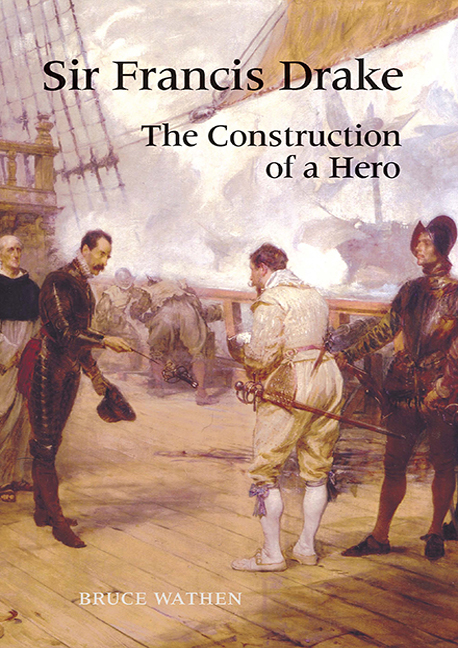Book contents
- Frontmatter
- Contents
- List of Illustrations
- Dedication
- Acknowledgements
- Introduction
- Chapter One Auxilio Divino
- Chapter Two ‘Sir Francis Drake Revived’
- Chapter Three ‘Behold the warrior dwindled to a beau’
- Chapter Four ‘Homage to Britannia’
- Chapter Five ‘Who the New World Bade British Thunders Shake?’
- Chapter Six ‘The Prose Epic of England’
- Chapter Seven ‘Mould him in bronze’
- Chapter Eight ‘Gun to Gun he'll Challenge us’
- Chapter Nine ‘A pirate, and a good one’
- Chapter Ten The Future
- Bibliography
- Index
Chapter Seven - ‘Mould him in bronze’
Published online by Cambridge University Press: 11 May 2017
- Frontmatter
- Contents
- List of Illustrations
- Dedication
- Acknowledgements
- Introduction
- Chapter One Auxilio Divino
- Chapter Two ‘Sir Francis Drake Revived’
- Chapter Three ‘Behold the warrior dwindled to a beau’
- Chapter Four ‘Homage to Britannia’
- Chapter Five ‘Who the New World Bade British Thunders Shake?’
- Chapter Six ‘The Prose Epic of England’
- Chapter Seven ‘Mould him in bronze’
- Chapter Eight ‘Gun to Gun he'll Challenge us’
- Chapter Nine ‘A pirate, and a good one’
- Chapter Ten The Future
- Bibliography
- Index
Summary
Nearly all are thus men of the West Country, whose names are familiar to us as household words.
(Smith's Plymouth Almanac, 1876/7)During the final quarter of the nineteenth century the work of Charles Kingsley and James Anthony Froude continued to exert a powerful influence over the way in which the Elizabethan past was constructed.The bowls myth in particular seems to have caught the popular imagination. Although this had become an integral part of the Drake narrative by the 1840s, it was Westward Ho! that was chiefly responsible for the wide dissemination of the tradition in printed form. Kingsley was, in fact, becoming popularly identified as the source of the story.An article on the origins of the mythical game published in the Western Antiquary felt it necessary to clarify his relation to the narrative.‘Many people have imagined that the story originated with Charles Kingsley, who has woven it, with great tact, into his inimitable story. … But it is not an invention of this patriotic Devonian.’ The article went on to identify the tract Vox Populi as the earliest printed reference to the game. That the story was frequently attributed to Kingsley may seem to undermine the argument that I have put forward: if Drake as the bowls-playing Armada victor was a popular cultural tradition, then ‘many people’ would have recognized it as such. But, with print culture replacing oral culture, by the mid-century – and certainly by the 1880s – the novel-reading public would have had little access to the oral tradition.
It was to Westward Ho! that the stained-glass makers Heaton, Butler and Bayne turned when commissioned to produce a window commemorating the defeat of the Spanish Armada. The Armada Window, designed by the little-known artist J. Milner Allen, was one of a series of fourteen ‘historical’ windows that were to decorate the great hall of Plymouth's new guildhall, a building that claimed to be the finest public room in the west of England.This was created between 1870 and 1876. Like the removal of the last remaining conduit house in Plymouth, the new guildhall was erected as part of a scheme of urban improvement. It replaced a Jacobean building that did not provide an adequate expression of flourishing bourgeois pride.
- Type
- Chapter
- Information
- Sir Francis DrakeThe Construction of a Hero, pp. 123 - 142Publisher: Boydell & BrewerPrint publication year: 2009

